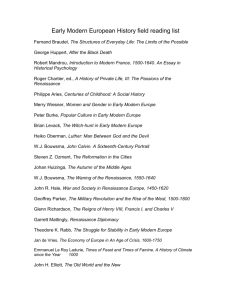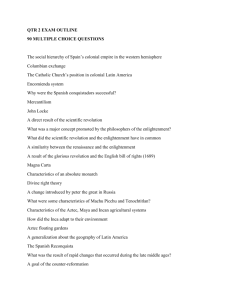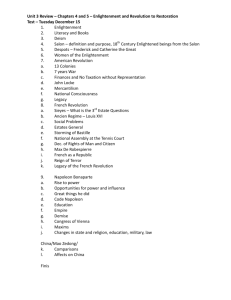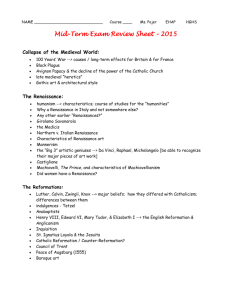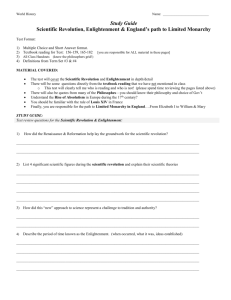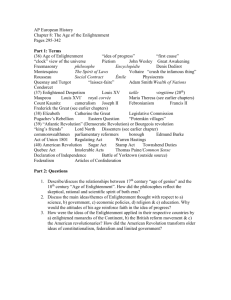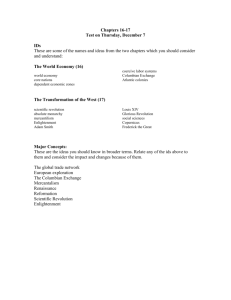Chapter 17 Review
advertisement
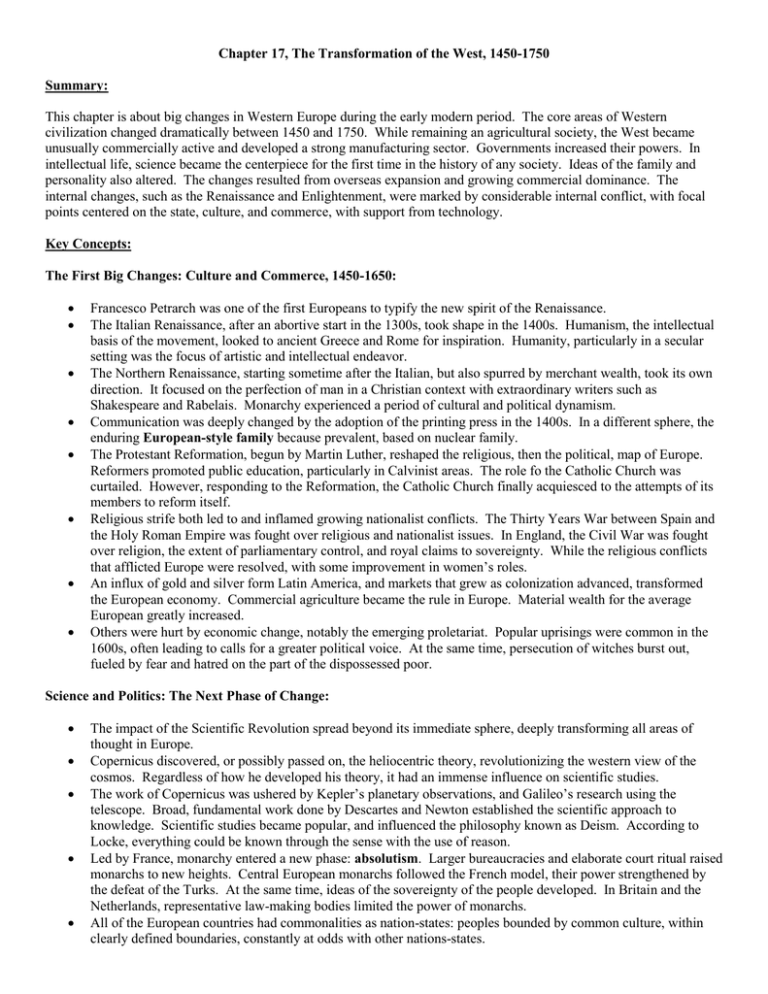
Chapter 17, The Transformation of the West, 1450-1750 Summary: This chapter is about big changes in Western Europe during the early modern period. The core areas of Western civilization changed dramatically between 1450 and 1750. While remaining an agricultural society, the West became unusually commercially active and developed a strong manufacturing sector. Governments increased their powers. In intellectual life, science became the centerpiece for the first time in the history of any society. Ideas of the family and personality also altered. The changes resulted from overseas expansion and growing commercial dominance. The internal changes, such as the Renaissance and Enlightenment, were marked by considerable internal conflict, with focal points centered on the state, culture, and commerce, with support from technology. Key Concepts: The First Big Changes: Culture and Commerce, 1450-1650: Francesco Petrarch was one of the first Europeans to typify the new spirit of the Renaissance. The Italian Renaissance, after an abortive start in the 1300s, took shape in the 1400s. Humanism, the intellectual basis of the movement, looked to ancient Greece and Rome for inspiration. Humanity, particularly in a secular setting was the focus of artistic and intellectual endeavor. The Northern Renaissance, starting sometime after the Italian, but also spurred by merchant wealth, took its own direction. It focused on the perfection of man in a Christian context with extraordinary writers such as Shakespeare and Rabelais. Monarchy experienced a period of cultural and political dynamism. Communication was deeply changed by the adoption of the printing press in the 1400s. In a different sphere, the enduring European-style family because prevalent, based on nuclear family. The Protestant Reformation, begun by Martin Luther, reshaped the religious, then the political, map of Europe. Reformers promoted public education, particularly in Calvinist areas. The role fo the Catholic Church was curtailed. However, responding to the Reformation, the Catholic Church finally acquiesced to the attempts of its members to reform itself. Religious strife both led to and inflamed growing nationalist conflicts. The Thirty Years War between Spain and the Holy Roman Empire was fought over religious and nationalist issues. In England, the Civil War was fought over religion, the extent of parliamentary control, and royal claims to sovereignty. While the religious conflicts that afflicted Europe were resolved, with some improvement in women’s roles. An influx of gold and silver form Latin America, and markets that grew as colonization advanced, transformed the European economy. Commercial agriculture became the rule in Europe. Material wealth for the average European greatly increased. Others were hurt by economic change, notably the emerging proletariat. Popular uprisings were common in the 1600s, often leading to calls for a greater political voice. At the same time, persecution of witches burst out, fueled by fear and hatred on the part of the dispossessed poor. Science and Politics: The Next Phase of Change: The impact of the Scientific Revolution spread beyond its immediate sphere, deeply transforming all areas of thought in Europe. Copernicus discovered, or possibly passed on, the heliocentric theory, revolutionizing the western view of the cosmos. Regardless of how he developed his theory, it had an immense influence on scientific studies. The work of Copernicus was ushered by Kepler’s planetary observations, and Galileo’s research using the telescope. Broad, fundamental work done by Descartes and Newton established the scientific approach to knowledge. Scientific studies became popular, and influenced the philosophy known as Deism. According to Locke, everything could be known through the sense with the use of reason. Led by France, monarchy entered a new phase: absolutism. Larger bureaucracies and elaborate court ritual raised monarchs to new heights. Central European monarchs followed the French model, their power strengthened by the defeat of the Turks. At the same time, ideas of the sovereignty of the people developed. In Britain and the Netherlands, representative law-making bodies limited the power of monarchs. All of the European countries had commonalities as nation-states: peoples bounded by common culture, within clearly defined boundaries, constantly at odds with other nations-states. The West by 1750: Political forms crystallized around 1750, with few important developments. Only Prussia under Frederick the Great showed any dynamism, improving agriculture and expanding religious toleration. The Enlightenment, the spread of the Scientific Revolution to all areas of intellectual endeavor, took hold in the 18th century. With great faith in the goodness and capacity of humanity, and the power of the human intellect, Enlightenment thinkers set out to fix the world. The movement took place in salons, in coffee houses, in lecture halls, and was promoted by the growth of scholarly journals. Consumer demand for imported products influenced colonization. Agriculture developed with improved drainage and the importation of New World crops. Manufacturing, fueled by capitalism and employing large numbers of workers, increasingly drove the economy. Developments in commerce, the economy, and political forms were largely independent, but together they transformed the West. Key Terms: Humanism Scientific Revolution Enlightenment Capitalism Johannes Gutenburg Martin Luther Niccolo Machiavelli Isaac Newton Proletariat Jesuits Essay Questions: The Transformation of the West, 1450-1750 1. In what ways was Western Europe in 1750 different from the medieval West? 2. How would you contrast the Renaissance and the Scientific Revolution? 3. In what ways did the commercial revolution of the 16th century change the social structure of the West? 4. How was the absolute monarchy of the 17th century different from the political forms of the Middle Ages? 5. How did the Enlightenment affect changes in popular outlook in European society?
